Estimating the Used and Virtual Water and Their Impact on The Total Water Footprint of Dates In The Kingdom of Saudi Arabia
Adel M. Ghanem1, Khalid N. Alrwis1, Nashwa Abdul hamid Al-tatawi2, Sahar Abdel Moneim kamara3 and Said Azali Ahamada1
1Office of Food Security Studies and Research, Vice Presidency for Graduate Studies and Scientific Research, King Saud University, Saudi Arabia
1Professor of Agricultural Economics, Faculty of Agriculture, Alexandria University, Egypt
1Head of Research, Agricultural Economics Research Institute, Agricultural Research Center, Egypt
Submission:January 06, 2025;Published: January 17, 2025
*Corresponding author:Adel M. Ghanem, Office of Food Security Studies and Research, Vice Rectorate for Postgraduate Studies and Scientific Research, King Saud University, Saudi Arabia
How to cite this article: Adel M. G, Khalid N. A, Nashwa Abdul hamid Al-t, Sahar Abdel Moneim k, Said Azali A. Estimating the Used and Virtual Water and Their Impact on The Total Water Footprint of Dates In The Kingdom of Saudi Arabia. Ann Soc Sci Manage Stud. 2025; 11(3): 555811.DOI: 10.19080/ASM.2025.11.555811
Abstract
Purpose: This study aimed at estimating the used and virtual water and their impact on the total water footprint of dates in the kingdom of Saudi Arabia during the period 2000-2022.
Methodology: To achieve its objectives, this study relied on secondary data and economic equations as well as econometric analysis.
Findings: This study showed that the total quantity of accumulated water used in the production of dates amounted to 33.07 billion m3, with a value of 15.87 billion riyals. The cumulative virtual water quantity of date exports and its import counterpart was 2732.07 and 152.43 million m3 each respectively. The average self-sufficiency rate of domestic water resources was 99.64%, while the average dependence on foreign water imports does not exceed 0.46%. It was found through the estimated econometric model that the expansion of the area and production of dates and the orientation towards export, led to an increase in the total water footprint of dates. Finally, considering the reduction of the quantity of water available for the agricultural sector which is 6.2 billion m3 in accordance with the Kingdom’s Vision 2030, it is necessary to stabilize the area of dates and shorten the process of replacement for trees with high quality varieties only, in addition to reconsidering the policy of exporting dates abroad.
Originality: The research is original and unique in estimating the water footprint and virtual water of the most important fruit crops (dates) in Saudi agriculture.
Keywords:Water Consumption; Virtual Water; Water Footprint; Dates; Foreign Trade
Introduction
Dates are the most important fruit crops in the Kingdom of Saudi Arabia and occupy a significant economic position in Saudi agriculture, as the area of date palm reached 156.5 thousand hectares, representing 72.4% of the total fruit area and about 29.3% of the crop area of 534.5 thousand hectares in 2022. The area of date palms increased from 142.45 thousand hectares in 2000 to 156.5 thousand hectares in 2022, helped by the increase in the value of subsidies for palm and date shoots from 30.05 million riyals in 2000 to 199.23 million riyals in 2022 [1].
Due to the expansion of date palm cultivation, the quantity of water used for dates production has increased. A study [2] showed an increase in the quantity of water utilized in the production of dates from 735.37 million m3, representing 6.53% of the total volume of water used for agricultural purposes in 1990 to 1197.67 million m3, expressing 5.95% of the total quantity of water utilized for farming purposes in 2019. Dates are known to be water-draining crops. Considering the scarcity of water, this study recommended not expanding palm cultivation while allowing the substitution of high-quality date varieties with cheap ones.
These results are consistent with the findings of the study [3] in the part related to comparing the average export prices of dates of 4.01 thousand riyals / ton, with the average production costs of 4.12 thousand riyals / ton considering the inclusion of the cost of irrigation water, the average coverage rate of export prices for average production costs reached 97.3% during the period 2010- 2015. Considering the marketing costs associated with dates, the economic logic is not to expand the production and export of dates but to satisfy the requirements of local consumer needs.
A study [4] showed that relying on local agriculture to achieve food security resulted in several adverse effects, the most important of which are (1) the depletion of water resources that are characterized by relative scarcity, (2) the decline in the economic size of the agricultural sector, due to the channeling of some water resources to the cultivation of crops with low productivity per unit of water, where dates ranked thirteenth in the value of productivity per unit of water, (3) a decrease in the area planted with the rest of the crops prevailing in the structure of the crop structure, and (4) lack of utilization of virtual water Gained from Saudi import and agricultural investment abroad.
A study [5] concerned with estimating the water footprint and the amount and value of virtual water gained from Egyptian agricultural import and investment abroad to achieve relative food security for wheat. This study showed that the water footprint of wheat in Egypt increased from 6.06 billion m3 in 1990 to 11.78 billion m3 in 2013. The average percentage of dependence on foreign water imports of wheat was 49.2%; thus, the average percentage of self-sufficiency of local water resources for wheat was 50.8% during the study period. The total quantity of virtual water gained from Egyptian agricultural import and investment abroad to achieve the complete level of food security for wheat ranged from a minimum of 4.21 billion m3 with 463.3 million pounds to a maximum of 12.48 billion m3 worth 1.37 billion pounds at a 95% confidence level.
A study [6] showed that the total cumulative net virtual water quantity of citrus fruits was 5594.98 million m3 at the end of the period 2005-2016. The value of net virtual water increased from 238.53 million riyals, representing 32.6% of the value of Saudi net imports of citrus fruits in 2005, to 333.84 million riyals, expressing 26.79% of the value of Saudi net imports of citrus fruits in 2016. This study recommended the need to expand citrus production, especially in priority areas in citrus cultivation, which leads to savings for the Saudi economy of 109.63 million riyals considering the inclusion of the cost of water.
Due to the increase in local production of dates from 734.8 thousand tons in 2000 to 1.61 million tons in 2022, the ratio of the quantity of exports to the local production of dates increased from 3.84% in 2000 to 19.9% in 2022, and the percentage of selfsufficiency of dates increased from 104% in 2000 to 124% in 2022 [1]. The country has tended to expand exports, as the quantity of Saudi exports of dates increased from 28.25 thousand tons with a value of 18.32 million dollars in 2000 to 321.15 thousand tons with a value of 308.56 million dollars in 2022 [7]. Saudi Arabia is known to suffer from water scarcity. Dates are water-draining crops, and the export of dates includes a quantity of virtual water, so the expansion of the area and production of dates with rising temperatures leads to an increase in the quantity of water used in the agricultural sector.
Research Objectives:
This study aimed at estimating the used and virtual water and
their impact on the total water footprint of dates in the kingdom
of Saudi Arabia during the period 2000-2022, by studying the
following:
i. The current situation of production, export and import
of dates to the Kingdom of Saudi Arabia.
ii. Estimating the quantity and value of water used in the
production of dates.
iii. Estimating the quantity and value of virtual water
and the internal and external water footprint of dates and their
indicators for the Kingdom of Saudi Arabia.
iv. Estimating the proposed model to measure the impact
of expansion in production and foreign trade on the total water
footprint of dates in the Kingdom of Saudi Arabia.
Study Methodology:
This study relied on secondary data published in (1) the statistical book issued by the Ministry of Environment, Water and Agriculture, (2) the FAOSTAT website, and (3) studies concerned with estimating the water needs of different crops prevailing in the crop composition of the Kingdom [8]. This study also relied on achieving its objectives on economic equations and econometric analysis. Which are:
(A) Economic equations used in estimating the quantity and value of virtual water.
i. Quantity of water used in dates production (QWdp) =
Area planted with palm trees (APpt) × Average water requirement
per hectare (AWRUh).
ii. Value of water used in date production (VQWdp) =
Quantity of water used in date production (QWdp) × cost or unit
price of water resources used in date production (CUPWdp).
iii. Quantity of virtual water exported abroad (VQWexp) =
Quantity of date exports (QEXPd) × Average water requirement
per unit produced or ton (CURWdp).
iv. Value of virtual water exported abroad (VVQWexp.) =
Quantity of date exports (VQWexp) × Cost or unit price of water
resources used in date production (CURWdp).
v. Quantity of virtual water gained from import
(QVWGimp) = Quantity of imported dates (VQWexp) × Average
water requirement per unit produced or ton (CURWdp).
vi. Value of virtual water gained from dates import
(VQVWGimp) = Quantity of virtual water gained from import
(QVWGimp) × Cost or unit price of water resources used in dates
production (CUPWdp).
(B) Economic equations used in estimating the total water footprint of dates, which are as follows [5]:
i. Internal water footprint of dates (IWFd) = Quantity
of water used in local production of dates (QWdp) - Quantity of
virtual water within date exports to other countries (VQWexp).
ii. External water footprint of dates (EWFd) = Quantity of
virtual water gained from importing dates (QVWGimp) - Quantity
of virtual water re-exported from imported dates.
iii. Total water footprint of dates (TWFd) = Internal water
footprint (IWFd) + External water footprint (EWFd).
iv. Dependence on foreign water imports ratio (PDEWimp)
= [external water footprint (EWFd) ÷ total water footprint
(TWFd)] × 100.
v. Domestic water resources self-sufficiency ratio
(RSSWRloc) = [internal water footprint (IWFd) ÷ total water
footprint (TWFd)] × 100.
(C) The proposed model for studying the impact of the expansion of production and foreign trade on the total water footprint of dates:
The proposed model consists of three behavioral equations as
follows:

The equations of the proposed model include the following
variables:
Endogenous variables consist of three components: the
quantity of water utilized in the production of dates (Y1), the
quantity of water employed in Saudi Arabia’s net foreign trade of
dates (Y2), and the total water footprint of dates (Y3).
Exogenous variables comprise four elements, namely the ratio of the area cultivated with date palms to the total crop area (X1), average temperature (X2), the quantity of Saudi date exports (X3), and the quantity of Saudi date imports (X4). The proposed model was estimated by the ordinary least squares (OLS) method, following the verification of the stability of both endogenous and exogenous variables in the model. This assurance was established through unit root tests, with the Extended Dickie Fuller test (William, 2003) being the most significant among them.
Research Concepts:
Virtual Water: It means the quantity of water involved in the
production of goods that are exported and imported from abroad,
and therefore, the export and import operations of any commodity
include the export and import of the quantity of water used in its
production [9]. The concept of virtual water allows the import of
water through the import of goods and products that consume
the most water and permits the production and export of goods
and products with low water needs. Water-scarce countries can
conserve their water resources through virtual water acquired
from importing goods and products with high water needs, thus
overcoming the problems of scarcity of local water resources [10].
Water footprint: Water footprint means the total quantity of
fresh water used in the production of goods and services consumed
by an individual or society. The water footprint consists of two
parts: the internal water footprint and its external counterpart.
The Internal Water Footprint includes the quantity of virtual water
used for agricultural, industrial, and domestic purposes minus the
quantity of water exported through agricultural products to other
countries. External Water Footprint is the difference between the
quantity of virtual water imported from abroad and the quantity
of virtual water re-exported from imported products [11].
Research results
First: The current situation of production, export and import of dates to the Kingdom of Saudi Arabia
Studying the current situation of production, export and import of dates to the Kingdom of Saudi Arabia during the period 2000-2022, it is clear from the data provided in (Tables 1, 2 & 3) that the area planted with date palms increased, therefor the local production of dates increased from 734.84 thousand tons in 2000 to 1610.73 thousand tons in 2022, means it augmented at an annual growth rate of 3.1% during the study period. Due to the development of technological processes and methods and the increase in farmers’ experience, productivity increased from 5.16 tones/ha in 2000 to 10.29 tones/ha in 2022, expended at an annual growth rate of 3.7% during the study period.
Due to the increase in population and real per capita income, domestic consumption of dates increased from 706.71 thousand tons in 2000 to 1298.97 thousand tons in 2022, increased at an annual growth rate of 2.4% during the study period. The selfsufficiency rate for dates increased from 104% in 2000 to 124% in 2022, increasing at an annual growth rate of 0.6% during the study period. The Kingdom of Saudi Arabia relied on local production to meet the consumption needs of dates, the period of production sufficiency for local consumption extended from 379.5 days in 2000 to 452.6 days in 2022, showing an annual growth rate of 0.6% throughout the study period.
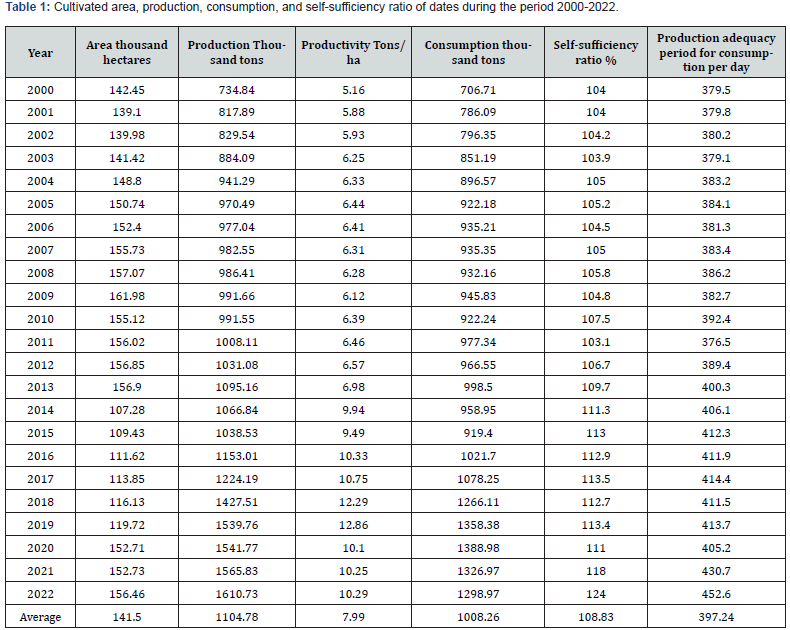
Source: collected and calculated from: (1) Ministry of Environment, Water and Agriculture [1]. Statistical book, (2) (FAO) [2], 2000-2022.
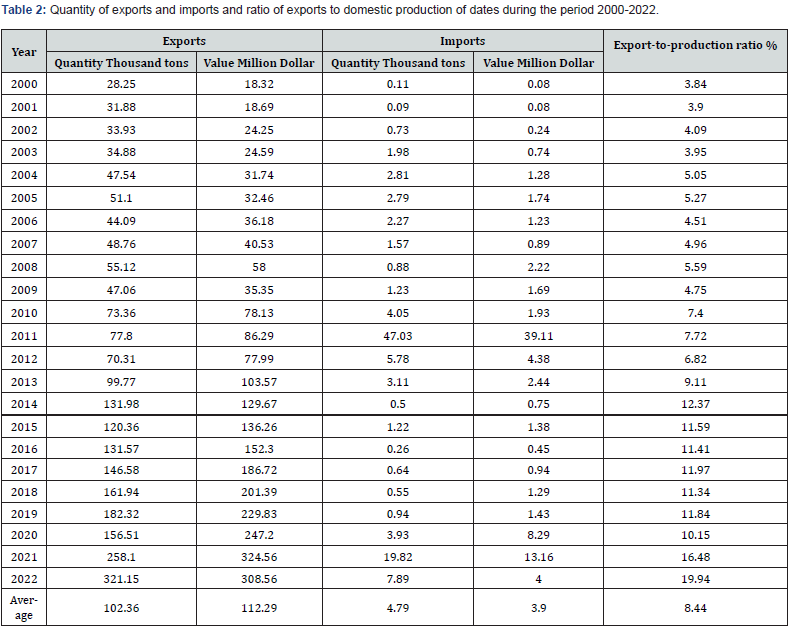
Source: FAO, 2000-2022.

** Significant at the probability level of 1%, ns non-significant.
Source: Data collected and calculated from (Tables 1, 2).
The quantity of Saudi exports of dates increased from 28.25 thousand tons, representing 3.84% of domestic production in 2000, to 321.15 thousand tons, accounting for 19.94% of domestic production in 2022, the quantity of exports of dates and their ratio to local production increased at an annual growth rate of 10.1%, 7.1% respectively. The value of Saudi exports of dates increased from 18.32 million dollars in 2000 to 308.56 million dollars in 2022, increasing at an annual growth rate of 13.7%. Although the annual growth rate of the quantity of Saudi imports of dates is not significant, the value of imports increased at an annual growth rate of 12.1% during the period 2000-2022.
Second: Estimating the quantity and value of water used in dates production
The quantity of water used in date production was estimated considering the area planted with palm trees and the average palm water requirement of 10.16 thousand m3/ha (Al-Amoud et al., 2010). The data in Tables (4, 5) and (Figure 1) shows an increase in the quantity of water used in the production of dates from 1.45 billion m3, representing 8.04% of the total volume of water utilized for agricultural purposes in 2000, to 1.59 billion m3, expressing 20.97% of the total amount of water used for farming purposes in 2022. Although the quantity of water consumed in the agricultural sector decreased at an annual rate of 2.3%, the ratio of the quantity of water used in the production of dates to the total volume of water used for agricultural purposes increased at an annual growth rate of 2.38% during the study period. The average share of water produced in date production decreased from 1.97 thousand m3/ton in 2000 to 0.99 thousand m3/ton in 2022, a decrease of 3.7% per year.
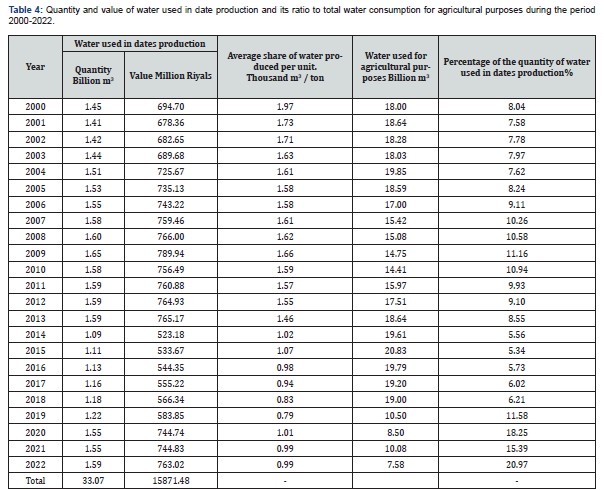
Source:Collected and calculated from: (1) the data provided in (Table 1), (2) Al-Amud, Ahmed bin Ibrahim et al. [8]. A guide for estimating crop water needs in the Kingdom of Saudi Arabia, King Abdulaziz City for Science and Technology, General Administration of Research Grants.
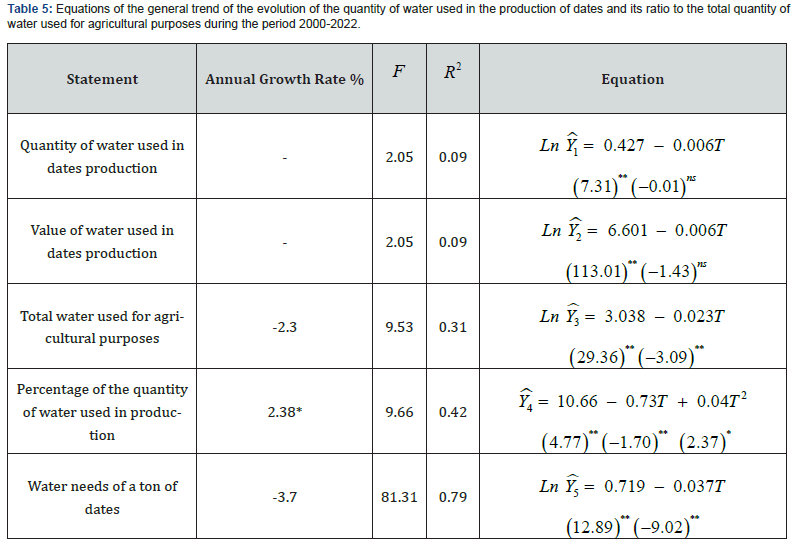
** Significant at the probability level 1%.
Source: Data collected and calculated from (Table 4).
*The annual growth rate was calculated from the following law:

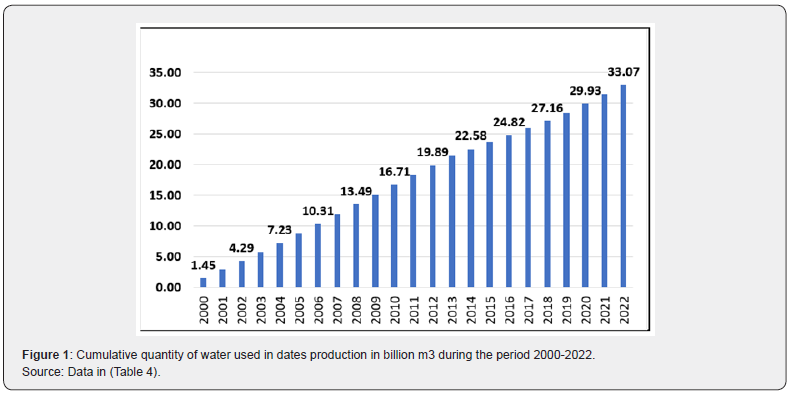
Considering the average groundwater extraction cost of 0.48 SAR /m3 (Nashwan et al., 2016), the value of water used in date production increased from SAR 694.7 million in 2000 to SAR 763.02 million in 2022. By calculating the total amount of accumulated water consumed in the production of dates, it amounted to 33.07 billion m3, with a value of 15.87 billion riyals at the end of the period 2000-2022.
Third: Estimation of virtual water and the internal and external water footprint of dates and their indicators For the Kingdom of Saudi Arabia Estimation of the quantity and value of virtual water for date exports:
Virtual water for Saudi date exports, estimated by multiplying the amount of Saudi exports of dates by the average share of the unit produced by the quantity of water used. It is clear from the data provided in (Table 6) and (Figure 2) that the quantity of virtual water for date exports increased from 55.65 million m3, representing 3.84% of the quantity of water used in date production in 2000, to 317.94 million m3, representing 20.0% of the quantity of water used in date production in 2022. Considering the average cost of groundwater extraction of 0.48 SAR /m3 [12], the value of virtual water for date exports increased from 26.71 million SAR in 2000 to 152.61 million SAR in 2022, the quantity and value of virtual water for date exports increased at an annual growth rate of 6.4%. The ratio of the quantity of virtual water for exports to the quantity of water used in the production of dates increased at an annual growth rate of 7.1%, while the ratio of the value of virtual water for date exports to the value of Saudi exports for dates decreased at an annual rate of 7.2%. Calculating the cumulative virtual water quantity of date exports, it amounted to 2732.07 million m3, with a value of 1311.41 million riyals at the end of the period 2000-2022.
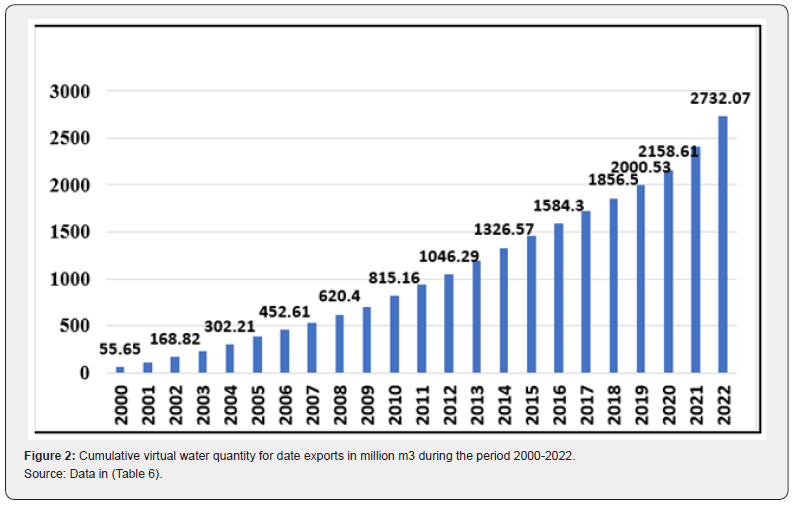
Estimation of the quantity and value of virtual water gained from importing dates:
It is also evident from the data in (Table 7) and (Figure 3) that the amount of virtual water gained from importing dates increased from 0.22 million m3 with a value of 0.10 million riyals in 2000 to 73.84 million m3 with a value of 35.44 million riyals in 2011, and then decreased to 7.81 million m3 with a value of 3.75 million riyals in 2022. Calculating the cumulative virtual water gained from importing dates, it amounted to 152.43 million m3, with a value of 73.15 million riyals at the end of the period 2000- 2022. The annual growth rate in the quantity and value of virtual water gained from importing dates during the study period was also insignificant.
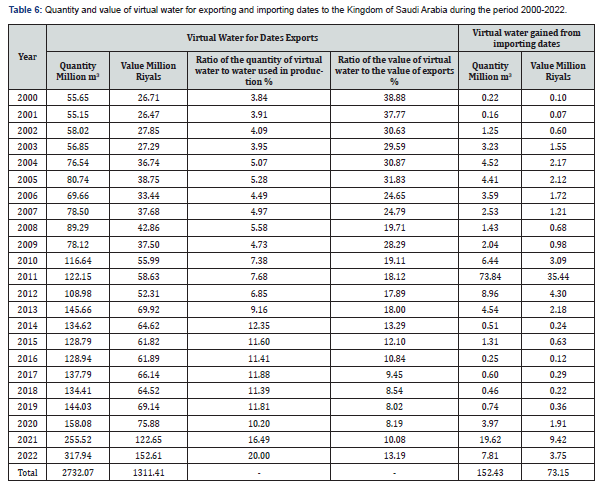
Source: collected and calculated from: (1) data in (Table 2), (2) column, Ahmed bin Ibrahim et al. [8]. A guide to estimating the water needs of crops in the kingdom of Saudi Arabia, King Abdulaziz City for science and Technology, General Directorate of research grants.
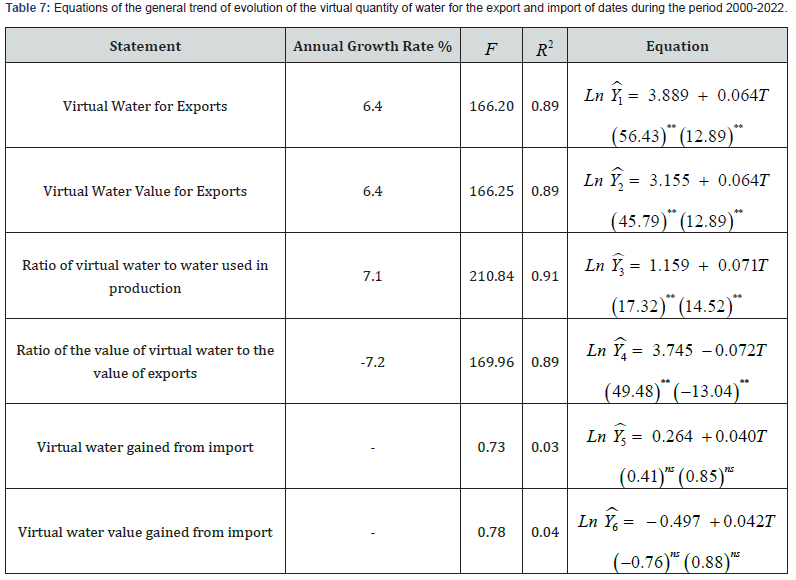
** Significant at the probability level of 1%, ns is non-significant.
Source: Data collected and calculated from (Table 6).
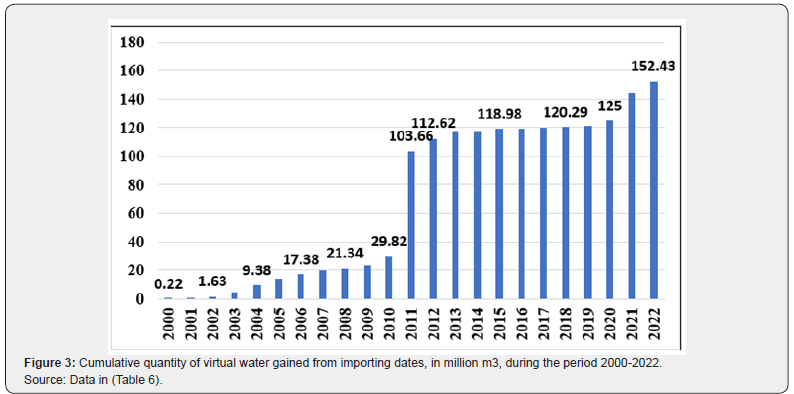
Estimating the internal and external water footprint and its indicators for dates:
The internal and external water footprint of dates was estimated by estimating the quantity of water used in the production of dates and the quantity of virtual water gained from the import of dates and their outgoing counterparts within the quantities exported throughout the period 2000-2022. It is clear from the data provided in (Tables 8 & 9) that the internal water footprint of dates ranged from a minimum of 955.34 million m3 in 2014 to a maximum of 1567.6 million m3 in 2009, with an annual average of 1318.85 million m3. The external water footprint of dates ranged from a minimum of 0.16 million m3 in 2001 to a maximum of 73.84 million m3 in 2011, with an annual average of 6.63 million m3.
From the above, the total water footprint of dates ranged from a minimum of 955.85 million m3 in 2014 to a maximum of 1569.64 million m3 in 2009, with an annual average of about 1325.48 billion m3. Both the internal and total water footprint declined at an annual rate of 1.3% and 1.2%, respectively, while the growth of the external water footprint was found to be insignificant due to the annual growth rate of both the quantity of Saudi imports and the quantity of water gained from importing dates during the study period.
By studying the indicators of the total water footprint of dates during the period 2000-2022, it is also apparent from the data provided in (Tables 8 & 9) that the percentage of dependence on foreign water imports ranged from a minimum of 0.01% in 2001 to a maximum of 4.79% in 2011, with an annual average of 0.46% during the study period. The self-sufficiency rate of local water resources ranged from a minimum of 95.5% in 2011 to a maximum of 100% during most years, with an annual average of 99.64% during the study period.
Fourth: Estimating the proposed model to measure the impact of expansion in production and foreign trade on the total water footprint of dates
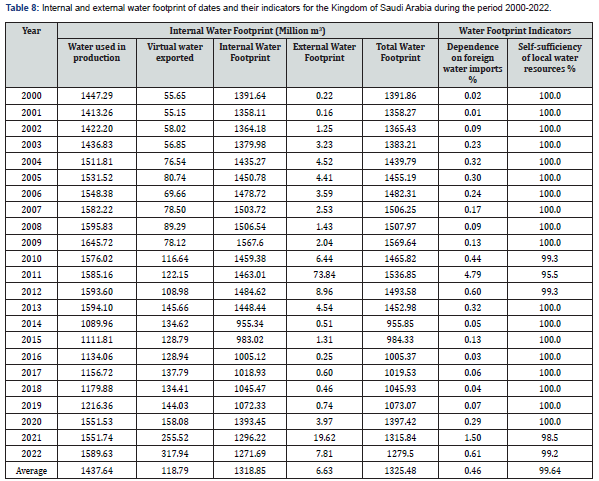
Data collected and calculated from (tables 4, 6).
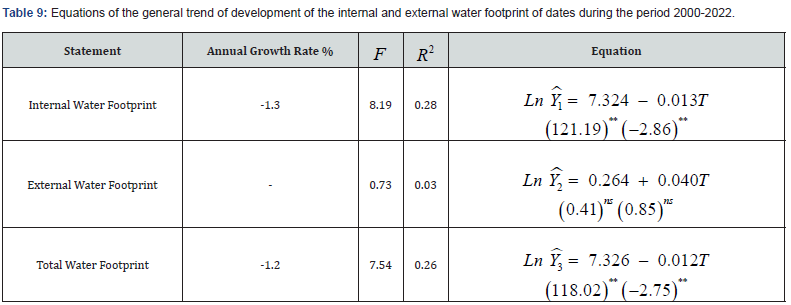
** Significant at the probability level of 1%, ns non- significant.
Source: Data collected and calculated from (Table 8).
Estimating the proposed model requires testing the stability of the variables, using the Augmented Dikey -Fuller Test (ADF). It is clear from the data in (Table 10) that alle endogenous and exogenous variables contain unit root, that is they are unstable, as the calculated value of (t) is less than the critical values at the level of 5%. Taking the first differences of these variables, all of them have become stable, means do not contain unit root, as the calculated value of (t) has become greater than the critical values at a significant level of 5% or 1%, and then the variables are integrated from the first order and stable.
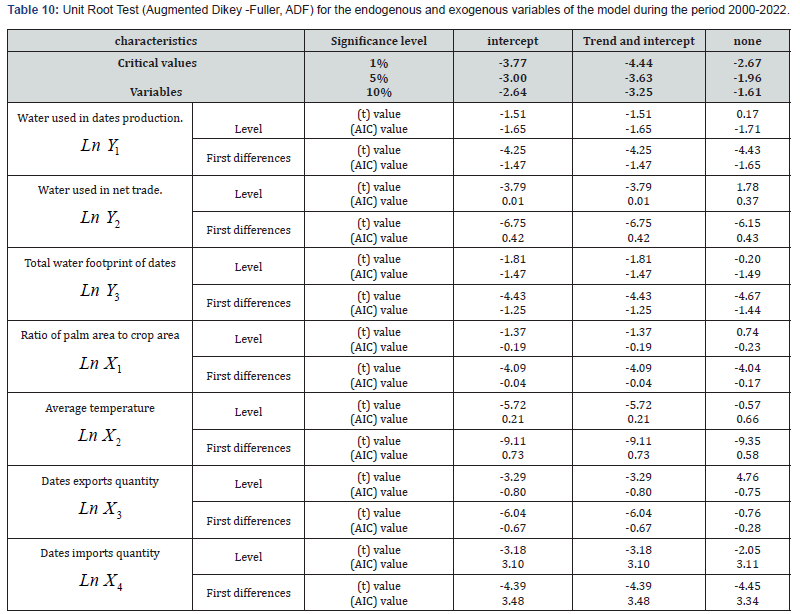
Source: Collected and calculated from statistical analysis of endogenous and exogenous variables of the proposed model.
The equations of the proposed model to measure the impact of expansion in both production and foreign trade on the total water footprint of dates during the period 2000-2022 were estimated using multiple regression analysis in double logarithmic form, by ordinary least squares (OLS) method [13], which can be expressed in the equations given in (Table 11).
The estimated model shows that: (1) increasing the ratio of date palm cultivated area to crop area (X1) and average temperature (X2) by 10%, leading to an increase in the amount of water used in date production by 3.9% and 2.05% respectively, (2) increasing the amount of Saudi exports of dates (X2) by 10%, increasing the quantity of virtual water for net foreign trade of dates by 6.68%, while the relative impact of the quantity of imports was found to be insignificant. Saudi Dates (X4),(3) increasing the estimated quantity of water used in the production of dates (Y1) by 10%, leads to an increase in the total water footprint of dates by 9.62%, while increasing the estimated amount of virtual water for the net foreign trade of dates (Y2) by 10%, leads to a decrease in the total water footprint of dates by 1.76%, and (4) the behavioral equations of the proposed model, free of the problem of auto-correlation of the remainders, according to the D.W. and Breusch-Godfrey Serial correlation LM test. It also has no autocorrelation in the variance of the series, according to the Arch Test. The behavioral equations in the proposed model have good efficiency in representing the data used in the estimation, according to the indicators measuring the efficiency of the model, the most important of which is the unequal coefficient of Thiel (U-Theil), whose value is close to zero (Table 12).
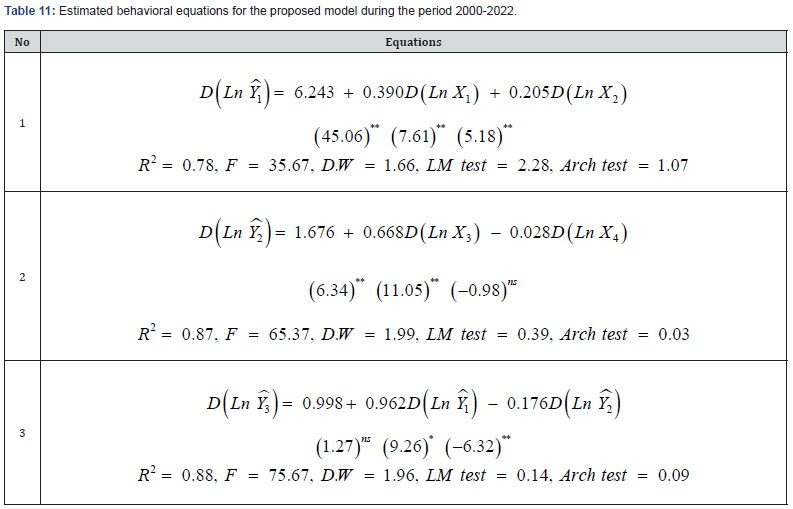
Source: Statistical analysis of the data used in this study.

Source: Equations of the estimated model in this study.
Conclusion
Dates are one of the most important fruit crops in Saudi agriculture, as the date palm area reached 156.5 thousand hectares, representing 72.4% of the total fruit area and about 29.3% of the crop area of 534.5 thousand hectares in 2022. Due to the expansion of the area planted with date palms from 142.45 thousand hectares in 2000 to 156.5 thousand hectares in 2022, the amount of water used in the production of dates increased from 1.45 billion m3, representing 8.04% of the total amount of water used for agricultural purposes in 2000, to 1.59 billion m3, representing 20.97% of the total amount of water used for agricultural purposes in 2022. The self-sufficiency rate for dates increased from 104% in 2000 to 124% in 2022. Despite the expansion of the area and production of dates, the average share of the unit produced in the amount of water used in the production of dates decreased from 1.97 thousand m3/ton in 2000 to 0.99 thousand m3/ton in 2022, a decrease of 3.7% per year. This is due to the expansion of the use of modern irrigation techniques that guide water consumption in the agricultural sector.
The quantity of Saudi exports of dates increased from 28.25 thousand tons, representing 3.84% of domestic production in 2000, to 321.15 thousand tons, representing 19.94% of domestic production in 2022, despite the conclusions reached by some studies [2,3] by comparing the average export prices of dates of 4.01 thousand riyals / ton, and the average production costs of 4.12 thousand riyals / ton. Under the inclusion of the cost of irrigation water, the rate of export price coverage of average costs Productivity reached 97.3% during the period 2010-2015. Considering the marketing costs of dates, the economic logic is not to expand the production and export of dates and to satisfy the requirements of local consumer needs.
Through the proposed model, it was found that the expansion of the area planted with date palms at the expense of other crops considering the high temperatures, leads to an increase in the amount of water used in the production of dates. The expansion of the export of dates also increases the amount of virtual water for net foreign trade, thus affecting the total water footprint of dates.
The agricultural sector is the most water-consuming sector, with the amount of water used in the agricultural sector reaching 20.83 billion m3, representing 83.9% of the total water consumption in the Kingdom in 2015 [14,15]. Due to water scarcity, the amount of water available to the agricultural sector has been reduced to 8.5 billion m3, representing 61.5% of the total water consumption in the Kingdom in 2020 [1], and the amount of water available to the agricultural sector has been reduced to 6.2 billion m3 in accordance with the Kingdom’s Vision 2030. Considering the scarcity of water and the low levels of non-renewable groundwater, which constitute the strategic water reserve in the Kingdom of Saudi Arabia, and the increase in the average ratio of the value of hypothetical water to the value of Saudi exports of dates, which amounted to 20.17% during the period 2000-2022. Considering the cost of other production elements and the marketing costs of dates, the export of dates considering the current prices becomes economically unfeasible for the Kingdom of Saudi Arabia, and therefore this study recommends the need to stabilize the area of dates and shorten the replacement process for trees with good varieties only, in addition to reconsidering the policy of exporting dates abroad.
Acknowledgement
The authors extend their sincere appreciation to the Deanship of Scientific Research at King Saud University for supporting the work.
References
- Ministry of Environment, Water and Agriculture (2022) Statistical book.
- Ghanem Adel Mohamed Khalifa and Al-Nashwan Ibrahim bin Othman (2021) The Food Sovereignty of Dates and its Impact on Water Consumption in the Kingdom of Saudi Arabia. Egyptian Journal of Agricultural Economics 31(2): 491-504.
- Ghanem Adel Mohammed Khalifa and Abdulaziz bin Mohammed Al-Dowais (2017) The Economic Dimension of the Production and Export of Dates to the Kingdom of Saudi Arabia. The Egyptian Journal of Agricultural Economics 27(2): 427-436.
- Ghanem Adel Mohammed Khalifa, Khalid bin Nahar Al-Ruwais and Othman bin Saad Al-Nashwan (2014) Integration and Economic Risks of Sources of Achieving Food Security for Wheat in the Kingdom of Saudi Arabia. The Eighth Conference of the Saudi Society for Agricultural Sciences (Integration between Internal and External Investment to Achieve Food Security in the Kingdom), College of Food and Agricultural Sciences, King Saud University, Saudi Arabia, pp. 29-30.
- Kamara Sahar Abdel Moneim (2014) Estimation of the water footprint and virtual water gained from import and foreign agricultural investment to achieve food security for wheat in Egypt. Egyptian Journal of Agricultural Economics 24(2): 535-552.
- Nashwan Othman S, ALRuwais Khalid bin Nahar, Adel Mohammed Khalifa Ghanem, Sharaf al-Din Bakri Ahmed and Nageeb Mohamed Aldawdahi (2018) The economic dimension of production and acquired virtual water from the Saudi foreign trade for citrus. Universidade Federal Rural de Pernambuco Departamento de Administracao Custos e@gronegocio online 14(2): 37-52.
- FAOSTAT (2000-2022).
- Al-Amud Ahmed Ibrahim, Fawzi Saeed Awad, Abdul Rahman Muhammad Al-Mushaileh, Jalal Muhammad Al-Badri, Abdul Rahman Ali Al-Athba (2010) A guide for estimating crop water needs in the Kingdom of Saudi Arabia, King Abdulaziz City for Science and Technology, General Administration of Research Grants.
- Hofwegan PV (2004) Virtual Water- Conscious Choices, World Water Council.
- Hassian, Kifah Mohammed (2012) Assessing the Water Situation in Syria through the Application of the Principle of Virtual Water in the Agricultural Sector. Damascus University Journal for Engineering Sciences 28(1): 69-84.
- Hoekstra AY and Hung PQ (2002) Virtual Water Trade: A Quantification of Virtual Water Flows between Nations in Relation to International Crop Trade. Value of water research report series, No. 11.
- Nashwan Othman S, Mohammad H Al-Qunaibet, Adel M Ghanem (2016) Estimating groundwater extraction cost and its efficiency use in dates production in Riyadh Region, Saudi Arabia. Universidade Federal Rural de Pernambuco Departamento de Administracao Custos e@gronegocio online 12(1): 282-289.
- William H Greene (2003) Econometric Analysis, Fifth edition, New York University, New York.
- Al-Nashwan Othman bin Saad, Mohammed Hamad Al-Qunaibet and Adel Mohammed Khalifa (2012) The impact of achieving self-sufficiency, food security and net exports of dates on water consumption in the Kingdom of Saudi Arabia. Journal of the Saudi Society for Agricultural Sciences 11(1): 77-97.
- Al-Rwis Khalid N, Adel M Ghanem, Nageeb M Aldawdahi and Sharaf al-Din B Ahmad (2015) The Economic Dimension of the virtual support in Saudi Arabia exports of red meat. Universidade Federal Rural de Pernambuco Departamento de Administracao Custos e @gronegocio online 11(2): 114-125.






























